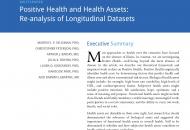FAQS
What is Positive Health?
Positive Health is the scientific study of people's strengths, or health assets, that can contribute to a healthier, longer life. It seeks to expand our view of health care beyond a system focused solely on treating and preventing disease to one that also works to promote people’s strengths. Positive Health works to discover which specific health assets produce a healthier, longer, higher-quality life, and which health assets lower disease risk and health care costs.
What are the goals of Positive Health?
The goal is health beyond the mere absence of illness. Positive Health works to identify which health assets produce more benefit—longer life, lower morbidity, lower health care expenditure, more years in good health, and better prognosis when illness strikes.
What is the difference between Positive Health and neutral health or negative health?
Traditional medicine is mostly focused on treating people in negative health—those who are ill and in need of treatment to alleviate illness. The goal of a traditional treatment regimen is to lift patients from negative health to a state that is neutral or free from disease.
But being healthy is more than living at the neutral threshold. Health care should encourage people to thrive—to live in Positive Health—by strengthening assets that have the potential to protect against illness and contribute to a healthier life. Positive Health encourages people to adapt to environmental changes and challenges, whether they are physical, chemical, or psychosocial. Positive Health encourages people to thrive.
What are some examples of health assets?
Positive Health assets can be broken down into three categories: biological factors, subjective factors, and functional factors.
- Biological factors are a part of your biological make-up. Generally they can be measured objectively through observation or simple medical tests. Biological factors include attributes such as exceptionally low blood pressure or low body mass index.
- Subjective factors are generally self-reported characteristics and include psychological states and traits like positive emotions, life satisfaction, optimism, meaning, and purpose.
- Functional factors are self-reported and include a person’s ability to effectively engage and perform in their environment. Examples include having close friends and family members, a stable marriage, the ability to climb two flights of stairs without being winded, and being able to carry out everyday duties.
Several research studies demonstrate that health assets such as emotional vitality, a stable marriage, and high heart-rate variability are associated with lower risk of cardiovascular disease.
Is Positive Health part of the way medicine is practiced now?
No. But Positive Health research has the potential to transform the way health care is practiced. Researchers are currently exploring the potential Positive Health has to lower costs and improve people's lives. Like Positive Psychology at its origin, Positive Health is being investigated empirically to find the extent to which these three classes of assets—biological, functional, and subjective—might actually create stronger health. Positive Health researchers believe that one day the practice will be incorporated into the mainstream health care system to ultimately increase your chance of a healthier, longer life.
How long will it be before I can receive Positive Health interventions?
With the support of the Robert Wood Johnson Foundation, researchers are in the process of identifying whether specific health assets can produce better health.
To do so, Positive Health researchers are taking existing data from completed longitudinal studies and reanalyzing it with new purpose. Until now, this data has only been examined for the negative—risk factors such as high blood pressure or poor aerobic fitness. But these studies also contain information about the participants’ positive health factors, such as optimism, exemplary blood pressure, and marital satisfaction. Positive Health takes largely ignored positive health assets and puts them at the center of research.
Once health assets are identified and validated, the next step is to explore what kinds of interventions may help people build these strengths so everyone can increase their chances of a healthier, longer life.
The definition of Positive Health is empirical, and as such every asset will be identified and validated through scientific study. When the time comes, interventions to boost these assets will also be scientifically validated.
How are Positive Health interventions different from traditional medical care interventions?
With traditional health interventions, a doctor or health provider addresses a risk factor or illness and provides a treatment to alleviate the negative factor. Once validated, Positive Health interventions will address your existing strengths—the health assets you have that you can build on to improve your health and protect against illness.
How is Positive Health different from the old paradigm of prevention?
Positive Health is more than prevention. Prevention establishes a risk factor and targets it via intervention to alleviate the risk. Positive Health identifies existing strengths that can be built up to maintain or improve health. Building good health assets may protect against future health problems, but the target is not always to prevent disease; the health assets are desirable in and of themselves and may encourage a thriving, flourishing life.




